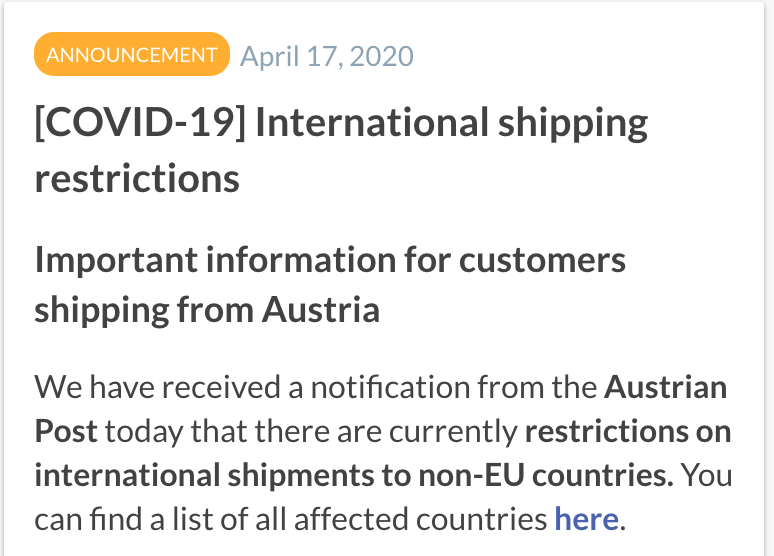The corona pandemic has led to a significant change in buyer behavior which caused a shift towards more eCommerce sales. While offline retailers had to suffer from severe losses during the lockdown period, many online shops recorded a strong increase in sales. In fact, in the US online retailers registered YoY (year-over-year) revenue growth of 68% in April and conversion rates that are comparable to Black Friday and Cyber Monday sales.
However, the increase in online sales also correlated with reduced logistics capacities due to the consequences of the spread of the coronavirus (namely lockdown, social distancing, etc.) resulted in many operational challenges for logistics companies and retailers. Even big players like Amazon were struggling with the increased demand and prioritized essential products over other non-essential goods, which caused significant delivery delays for certain shipments. Moreover, many retailers were not able to receive inventory from their suppliers because manufacturers had to shut down or borders were closed.
Considering the fact that during such a crisis, an omnichannel strategy can help businesses to generate sales online and survive, it is crucial to ensure that your business has the necessary capabilities optimized in order to remain fully operational during such extreme periods. That is why we have created a guide with 7 tips that helps retailers to reduce operational and supply-chain risks, ensuring the fulfillment of incoming orders, come hell or high water.
1. Keep your customers informed
Communication and transparency are key while going through tough times. Even when, or especially because consumers are aware of the problem, your customers need up-to-date information about their purchased orders. The outbreak of the coronavirus caused significant shipment delays and many parcels could not be shipped across borders which led to the sharp increase in inquiries from customers. In order to handle those, retailers had to ramp up their capacities for the support of online sales. Since shifting the workforce took some time, response times were delayed which resulted in many unhappy customers.
In order to avoid this, online retailers can do two things: First, getting ready for more customer requests due to a surge of digital sales and possible difficulties by increasing the workforce capacities accordingly. Second, online shops should proactively communicate with customers to keep them informed about (potential) consequences of fulfillment-related bottlenecks. This can be done via:
- Website: in the header section and in the checkout process
- E-Mails
- Social Media Channels

2. Optimize your Inventory management
It is always important to have a good overview of the number of products that are in stock at any given time. Especially, during times of crisis where supply deliveries are likely to be delayed and peaks might happen. Consequently, online retailers should aim to optimize their inventory management by having their stock synced in real-time across all sales channels and warehouses. This enables decision-makers to take action when needed and subsequently avoiding stock-outs.
3. Diversify your supply chain
The electronics industry faced severe issues with the factory shutdowns in China which are the largest suppliers for electronics. Other industries also had problems with closed factories and borders which made it impossible for businesses to receive deliveries in order to restock their inventory. This prevented many retailers from selling their products online and therefore from generating revenue.
In turn, many businesses started rethinking and reevaluating their current supply chain. Based on PWC’s study on connected and autonomous supply chain ecosystems, most successful companies (Digital champions) have recognized its importance and are putting smart logistics at the top of their agenda, meaning that they use connected devices and asset tracking tools throughout the supply chain to enable end-to-end visibility. In fact, 59% of these digital champions say it’s a high or even top priority, while 82% of them have already started implementing smart logistics.
Furthermore, governments have grasped the pitfalls of being dependent on long supply chain routes and want to change the dependency on Asian manufacturers. One possible solution is to source more from local suppliers. Whereas this is not possible for all products and raw materials, sourcing locally is feasible for many. This can contribute to minimizing the risk of supply chain issues, but also it is a more sustainable way of doing eCommerce business in general, which can help to strengthen your brand in the long run.
4. Distribute your inventory
Especially in eCommerce, there is now a strong noticeable trend towards on-demand warehousing and flexible warehousing solutions. In the beginning, online shops started outsourcing their fulfillment to decentralized warehouse-locations because this enabled them to offer expedited shipping to online shoppers, turning their logistics into a competitive advantage.
Nowadays, companies that have not been employing this strategy have a reason to switch to a more complex fulfillment network. For example, the main issue of having a single warehouse during the pandemic outbreak is that if one employee gets tested COVID-19 positive, the operations in this fulfillment center can be interrupted for a significant time period, making it impossible to fulfill any orders. Additionally, warehouses can be closed for safety reasons or because of legal measures, as has happened in April to six Amazon warehouses in France, causing elongated waiting times and spawning many unsatisfied customers. With more warehouses in your network, you can reduce the risk of losing your core fulfillment capacities and therefore remain operational, even in times of lockdowns.
On-demand and flexible warehousing also has the benefit of providing pay-as-you-go options and the possibility to scale up the inventory. The outbreak of the pandemic led to drastic changes in consumer behavior and subsequently had a strong impact on various retail categories. While some retail categories saw a strong increase in demand, others faced severe losses. You can find a good overview of rising retail categories here.

5. Focus on top-selling SKUs
As a company, you do not need to diversify your whole product portfolio across the warehouse network. That is why many retailers focus on their top-selling categories and SKUs. Having full flexibility for your top-selling SKUs will increase your chances of generating enough revenue to successfully ride out the crisis.
6. Choose flexible shipping options
Similar to a flexible warehouse solution, it is recommended to have flexible shipping options. This is an important aspect of logistics with regard to any peaks, such as seasonal ones before Christmas. Since shipping service providers also have to deal with increased volumes, service demands, and restrictions, this can result not only in significant shipment delivery delays but also in severe quality issues and undeliverable orders.
Moreover, customers prefer different parcel shipping providers and delivery methods, often depending on countries and regions. For instance, British online shoppers frequently abandon the cart, because their preferred parcel shipping provider is not listed as an option. However, not only the shipping providers but also the shipping methods can be decisive. While in Germany, Italy, Spain, and the UK only around 10% or less name pick-up points as their preferred delivery method, 45%, and 44% do so in France and Sweden respectively. At the same time, Poland leads regarding the popularity of parcel lockers with 36%, naming it as their favorite delivery method.
With the outbreak of the coronavirus pandemic, several logistics companies announced that they won’t be shipping to many countries anymore or have introduced many surcharges. In such cases, it is advantageous to have the possibility to switch between carriers and choose the best option. This flexibility can be beneficial with regard to different scenarios: technical errors, strikes, or other problems that create bottlenecks.

7. Use retail store capacities
In order to increase fulfillment capacities, omnichannel retailers can make use of their offline retail store capacities. One example is the US retailer Target that used its store network to fulfill online orders. Admittedly, this requires some preparation in order to ensure the right tools are in place and integrations are available to streamline the processes and synchronize stock levels accordingly. However, in addition, this also opens the door for retailers to offer an in-store click & collect solution to online shoppers.
8. Avoid shipping to quarantined regions
Last but not least, it is essential to have processes in place that avoid shipping parcels to quarantined regions. Sometimes, the transparent and up-to-date communication with your customers (described in 1.) won’t be enough to avoid receiving orders from online shoppers that are located in heavily affected and currently undeliverable regions. This will cause shipments to be returned to distribution and fulfillment centers. As a consequence, someone will have to pay for those return shipments and if you, as a retailer, do not take over those costs, you will most probably receive more customer complaints. Besides unfavorable word-of-mouth, 62% of the online shoppers state that they are unlikely to shop again at a webshop after a difficult return experience. That is why, besides having a good and clear communication strategy, it is necessary to have system alerts implemented that prevent orders from being fulfilled based on their destination address.
9. Keep your operational costs low
It is of crucial importance for any type and size of a company to review its variable and fixed monthly costs. This pandemic instantly reduced the average spending per consumer and will cause even worse consequences in the midterm. This means that every manager, director, or business owner, owes to re-consider the advertising spending, the cost of employee turnover, the technology stack costs (tools), and any other operational costs that occur on a monthly basis and could potentially be limited or optimized.
Conclusion: Remaining flexible is key
As highlighted in this article, remaining flexible with your e-commerce and retail business is key to successfully overcome not only the COVID-19 crisis but also a crisis in general. Some companies even expanded their product range to profit from rising retail categories, but also to optimize their supply chain by sourcing from local suppliers. This requires changes to your marketing, sales, and communication strategy, and various prerequisites such as an on-demand warehousing solution.
Therefore, having the right structure, tools, and processes in place is essential for a company, in general, to be in a good position to quickly adapt to changing circumstances in times of crisis. It is also very important to join big retail events, for example, Shoptalk, to be able to adjust to the new trends that are coming up in the post-Covid-area. Considering the 7 tips we have covered in this blog, you should be on the right path and in the position to keep your business running without having to lay off employees.
Author Bio:

David Mirzaei
David is a Marketeer and Startup-Enthusiast with a passion for e-commerce and sports. He works as Head of Marketing at byrd, a fulfillment company that provides a scalable logistics solution for online merchants, empowering them to efficiently grow their business.




